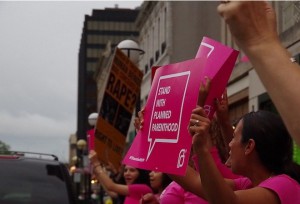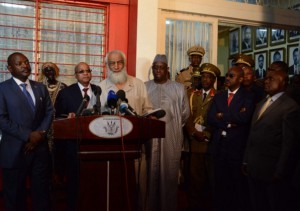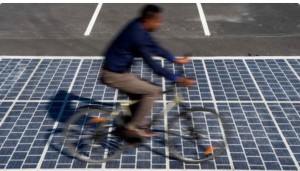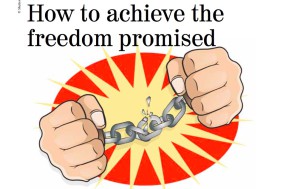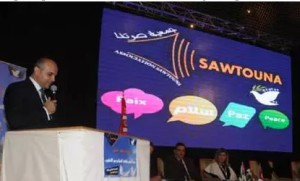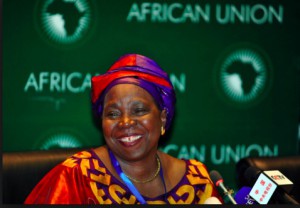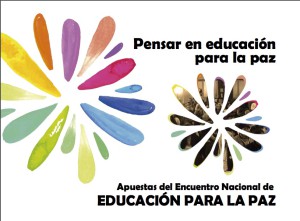. . . EGALITE HOMMES/FEMMES . . .
Un article de L’Actualité (reproduit dans un but non commercial)
Faire entendre celles qui n’ont pas de voix: c’est le combat quotidien de Bineta Diop. Envoyée spéciale de l’Union africaine (UA) pour les femmes, la paix et la sécurité depuis 2014, cette juriste de formation veut augmenter leur participation dans la prévention et la résolution de conflits. «La paix et la sécurité sont encore dominées par les hommes», déplore cette féministe de 66 ans, en boubou et turban turquoise.
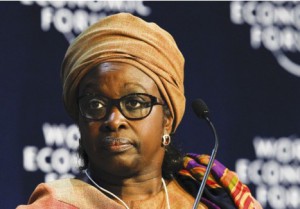
Bineta Diop. (Photo: EPA/Nic Bothma)
Fondatrice de l’association Femmes Afrique Solidarité, qui a permis depuis 1996 l’éclosion de mouvements féminins pour la paix sur le continent, cette femme de terrain consacre une bonne partie de son temps à la rencontre des réfugiées, des déplacées, des femmes dont les droits ont été violés. De la Somalie au Soudan du Sud, du Nigeria au Burundi, elle recueille leurs témoignages, dresse la liste des urgences, définit les actions à mettre en place.
Affronter des chefs d’État ne lui fait pas peur. En 2001, par exemple, avec une délégation de Guinéennes, Sierraléonaises et Libériennes, elle a convaincu le redouté Charles Taylor, alors président du Liberia, de participer à un sommet régional sur la paix, évitant ainsi le déclenchement d’hostilités. Elle a aussi collaboré à divers programmes de réconciliation en zones de crise et à des missions d’observation électorale postconflits. Et travaille en ce moment à la mise sur pied d’un indice pour suivre les progrès de la condition des femmes dans chaque pays d’Afrique.
Classée parmi les 100 personnes les plus influentes du monde par le magazine Time, en 2011, Bineta Diop garde espoir en dépit des violences qui ravagent toujours son continent.
«Ce qui me réconforte, c’est de voir que les femmes arrivent à se regrouper malgré tout, dit-elle. De les voir se réunir dans des conditions très difficiles, garder le sourire et ne jamais baisser les bras.»
L’actualité l’a rencontrée lors du Sommet mondial pour l’innovation en éducation (WISE), à Doha, au Qatar, où elle donnait une conférence.
Depuis 20 ans, Femmes Afrique Solidarité (FAS) travaille à l’engagement des femmes dans la prévention et la résolution de conflits. Quels sont ses principaux résultats?
FAS a permis aux femmes de s’organiser et d’acquérir des compétences pour devenir des leaders dans l’instauration de la paix. Les conflits violents ont des répercussions majeures sur les femmes, leur corps étant souvent utilisé comme une arme de guerre, un champ de bataille. Mais quand il s’agit de régler les problèmes, celles-ci ne sont pas invitées à la table de discussion, contrairement à ce que préconise la résolution 1325 du Conseil de sécurité des Nations unies. La mobilisation des femmes peut pourtant entraîner un changement d’attitude positif: nous pouvons être une armée sans armes. Cela amène des femmes chrétiennes, musulmanes et d’ethnies différentes à se parler, à élaborer des positions communes.
Comment arrivent-elles à passer outre à leurs différends, surtout quand elles ont autant souffert des conflits, ont été violées…
Pendant que les hommes s’entretuent, la société rend les femmes responsables de la famille, de l’éducation des enfants, des soins aux vieux… Elles ont donc un intérêt plus grand pour la paix et la sécurité. Et peuvent utiliser le fait d’être reconnues comme mères, comme sœurs, pour s’imposer. FAS offre des formations sur le continent pour les aider à comprendre les causes réelles de ces conflits, qui ne sont pas religieuses ou ethniques, mais liées au partage du pouvoir et des ressources. Une fois sensibilisées, elles arrivent très vite à transcender leurs différends, à mettre de côté leurs rancœurs.
(Voir suite sur colonne de droite. . . )
(Cliquez ici pour une version anglaise de cet article.)
Questions for this article:
Can the women of Africa lead the continent to peace?
(. . . suite)
La religion est-elle un moteur ou un frein pour la paix, à vos yeux?
Elle est utilisée pour enflammer les conflits, mais n’en est pas la source. Les hommes ont toujours utilisé à fond les régionalismes, les ethnies, pour défendre une stratégie politique. Et maintenant, les Boko Haram et autres al-Shabaab utilisent l’islam pour manipuler les gens. Beaucoup les écoutent, car ils ne sont pas instruits et ne comprennent même pas les textes religieux. Et dans les religions comme en politique, les femmes sont dominées et n’ont aucune voix.
Qu’est-ce qui a causé la prolifération de ces groupes terroristes?
La communauté internationale, nous tous, avons peut-être commis des erreurs. Certains dictateurs ont été renversés sans être remplacés, ce qui a créé un vide politique et de l’espace pour ces groupes. Et puis la pauvreté est un terreau fertile. Ces groupes infiltrent les populations, s’incrustent dans les familles, recrutent les jeunes désœuvrés en leur promettant le paradis et des vierges à n’en plus finir. Pour se faire apprécier des collectivités, ils leur donnent ce qui leur manque: l’eau, l’électricité, l’éducation de base… Et tout le monde ferme les yeux. D’autant qu’ils font régner la peur.
Comment les femmes peuvent-elles contribuer à leur démantèlement?
Elles sont de plus en plus nombreuses à vouloir se battre contre ces gens qui prennent leurs collectivités en otage et ne se préoccupent pas des intérêts de la population. La preuve, c’est que lorsque leurs dirigeants sont chassés d’un village par les militaires, ils s’empressent de brûler tout ce qu’ils avaient construit! Pour vaincre ces mouvements, il faut pousser l’État à venir tout de suite remplacer ce que al-Shabaab ou d’autres avaient mis en place. Les populations rêvent d’un monde meilleur, qu’on le leur donne! Mais pour le moment, personne ne parle de ça, on parle de sécurité militaire et de renseignement, mais pas des racines du problème: l’État qui faillit à ses responsabilités, le manque d’emplois…
Dans son récent livre Africanistan (Fayard, 2015), le chercheur français Serge Michailof craint que l’explosion démographique en Afrique ne produise les mêmes effets qu’en Afghanistan. Qu’en pensez-vous?
Il ne faut pas voir que le côté sombre, ce n’est pas le chaos partout en Afrique. Le continent a du potentiel, des ressources, et enregistre la croissance économique la plus importante au monde. Nous avons des terres cultivables, des lacs, du pétrole, du soleil… et la jeunesse qui peut, quand elle est bien outillée et motivée, soulever des montagnes. Mais il faut qu’on s’organise mieux. Si l’Afrique n’était pas aussi divisée, avec 54 pays qui se regardent le nombril, si on avait une politique d’ensemble, autour d’intérêts communs, on pourrait partager nos richesses.
C’est l’esprit du plan d’action panafricain Vision 2063, élaboré par l’UA?
Tout à fait! Pour le réaliser, nous avons consulté tout le monde: les jeunes, les femmes, les vieux, le secteur privé… Pour bâtir un continent prospère, où il y aura peut-être des conflits, mais moins de violence, et où on profitera enfin de nos ressources. Il y a une prise de conscience: les leaders politiques se rendent compte qu’ils doivent s’occuper des jeunes s’ils veulent avancer. Et de plus en plus de femmes s’impliquent, sont élues, deviennent chefs d’État. L’Afrique a assez souffert, il est temps que les hommes et les femmes de ce continent prennent leur destin en main, parce que personne ne le fera pour eux. L’un des objectifs de ce plan est de faire taire les armes avant 2020, et les femmes ont à coup sûr un rôle à y jouer.
Des formations pour la paix
Son expérience de travail en zones de conflit a motivé Bineta Diop à créer le Centre panafricain pour le genre, la paix et le développement, en 2005. Situé à Dakar, au Sénégal, le Centre offre des formations sur tout le continent, directement dans les collectivités.
